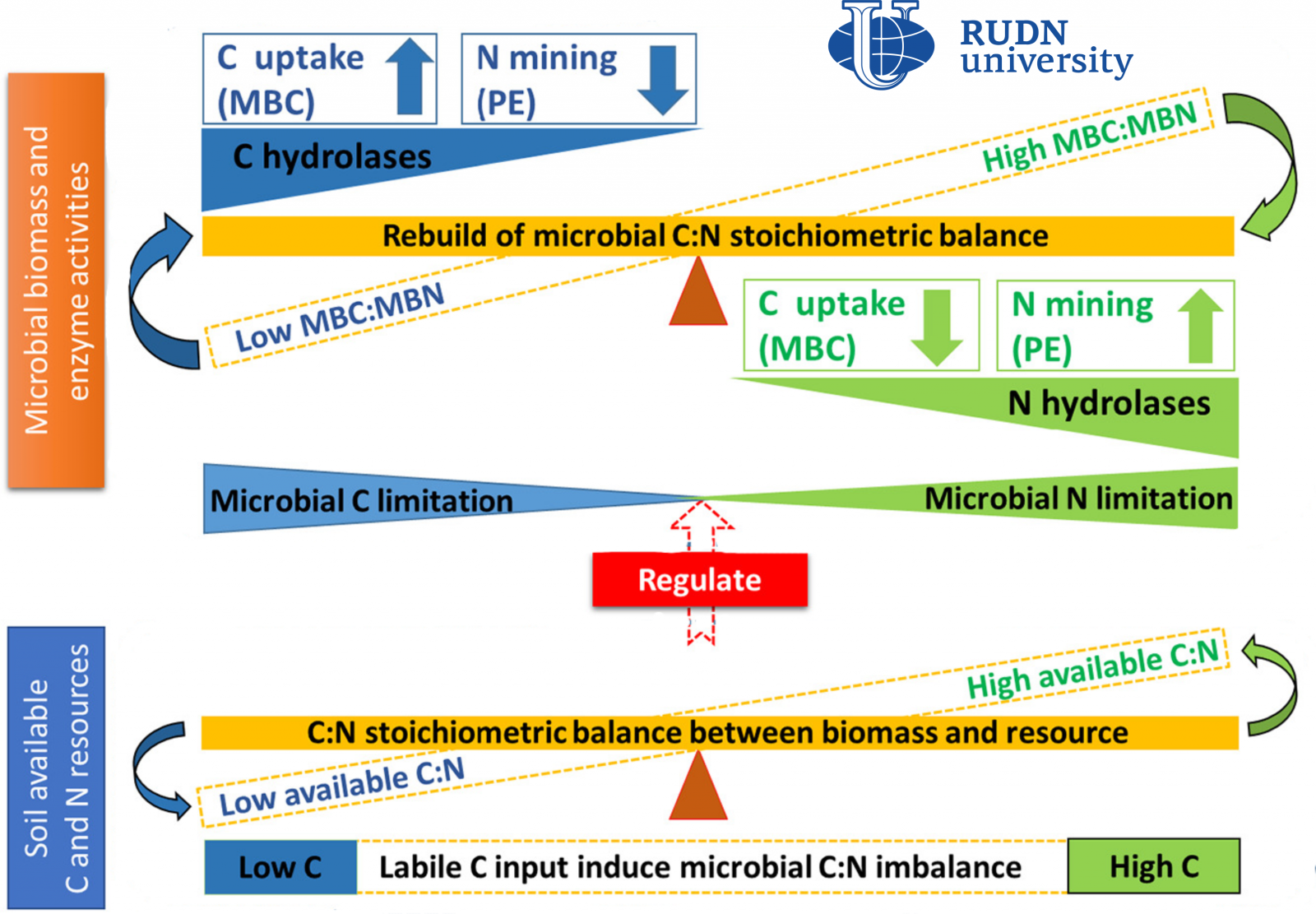A RUDN soil scientist found out the mechanism by which soil microorganisms regulate the carbon balance

Carbon, which is contained in the soil as part of organic residues, determines the health of the soil, its fertility and the stability of the ecosystem. Soil microorganisms consume plant residues and release from them carbon and nutrients (nutrients) necessary for themselves and for soil enzymes. The amount of nutrients that enters the soil after the decomposition of organic matter depends on the amount of carbon in plant residues and in the soil. However, how exactly microorganisms control the decomposition of organic matter and maintain this balance is still unknown. A RUDN soil scientist, together with colleagues from Germany, China, Saudi Arabia, and Sweden, found out how this happens.
“Microbes can control the ratio of carbon to nutrients within their community, depending on how much nutrients and carbon are contained within the organic compounds of the soil. In addition, they regulate the production of enzymes, which in turn control the release of nutrients in accordance with the needs of the microbial community. It turns out that the requirement of microorganisms for nutrients becomes a key regulator of the carbon cycle in the soil. We found out by what mechanisms this regulation takes place,”- said Doctor of Biology Yakov Kuzyakov, Leading Researcher at the Center for Smart Technologies for the Sustainable Development of the Urban Environment in the Conditions of Global Change, RUDN University.
Soil scientists studied soil samples obtained from experimental fields in Hunan province in southeast China. Since 1989, these fields have alternately grown rice and “mouse peas” – astragalus. Samples were taken from areas of fields that received different fertilizers – a pure NPK complex (nitrogen-phosphorus-potassium), NPK with the addition of chicken manure, NPK with the addition of straw. As control samples were taken from fields that were not fertilized at all. In total, soil scientists collected five samples at three different locations for each fertilizer regimen. The soil was dried, sifted through a sieve with 2 mm holes to remove plant debris and stones. Glucose was then added to the samples to test how the bacteria would restore the carbon balance, and they were flooded with water to mimic the conditions under which rice is grown. Soil scientists measured the amount of carbon dioxide and methane emitted, and using fumigation-extraction of chloroform, they determined the microbial composition and enzyme activity on the 2nd, 20th and 60th day of the experiment.
The introduction of additional glucose increased the ratio of carbon to nitrogen in the soil organic matter and thereby disturbed the balance of substances in the microbial biomass. However, it turned out that the microorganisms quickly coped with it. They began to actively extract nitrogen from organic matter and increased the production of the N-hydrolase enzyme. This effect is called priming. When the supply of additional carbon was exhausted, priming went in the opposite direction – microorganisms reduced the production of hydrolase and limited carbon consumption. This effect was most pronounced for soils that were fertilized with NPK and manure.
“Soil microorganisms change the production of carbon and N-hydrolase, and thus control the carbon balance,” – said Doctor of Biology Yakov Kuzyakov, Leading Researcher at the Center for Smart Technologies for the Sustainable Development of the Urban Environment in Conditions of Global Change, RUDN University.
The results are published in the journal Applied Soil Ecology. https://www.sciencedirect.com/science/article/abs/pii/S0929139321001530?via%3Dihub
RUDN summarized the results of the scientific competition "Project Start: work of the science club ". Students of the Faculty of Physics, Mathematics and Natural Sciences have created a project for a managed queuing system using a neural network to redistribute resources between 5G segments. How to increase flexibility, make the network fast and inexpensive and reach more users — tell Gebrial Ibram Esam Zekri ("Fundamental Computer Science and Information Technology", Master's degree, II course) and Ksenia Leontieva ("Applied Mathematics and Computer Science", Master's degree, I course).
The National Demographic Report, 2023 Demographic Well-Being of Russian Regions (hereinafter - the National Demographic Report) was prepared by the scientific team of the Institute of Demographic Studies of the Federal Research Center of the Russian Academy of Sciences, the Vologda Scientific Center of the Russian Academy of Sciences, Peoples' Friendship University of Russia, the Center for Family and Demography of the Academy of Sciences of the Republic of Tatarstan, as well as with the participation of leading scientists from the Republic of Bashkortostan, Stavropol Krai, Volgograd, Ivanovo, Kaliningrad, Nizhny Novgorod, Sverdlovsk Oblasts and Khanty-Mansi Autonomous Okrug–Yugra.
RUDN summarized the results of the scientific competition "Project Start: work of the science club ". Students of the Faculty of Physics, Mathematics and Natural Sciences have created a project for a managed queuing system using a neural network to redistribute resources between 5G segments. How to increase flexibility, make the network fast and inexpensive and reach more users — tell Gebrial Ibram Esam Zekri ("Fundamental Computer Science and Information Technology", Master's degree, II course) and Ksenia Leontieva ("Applied Mathematics and Computer Science", Master's degree, I course).
What is your first association with the word “laboratory”? Flasks and beakers? Microscopes and centrifuges? Yes, many of us would answer the same way.
The National Demographic Report, 2023 Demographic Well-Being of Russian Regions (hereinafter - the National Demographic Report) was prepared by the scientific team of the Institute of Demographic Studies of the Federal Research Center of the Russian Academy of Sciences, the Vologda Scientific Center of the Russian Academy of Sciences, Peoples' Friendship University of Russia, the Center for Family and Demography of the Academy of Sciences of the Republic of Tatarstan, as well as with the participation of leading scientists from the Republic of Bashkortostan, Stavropol Krai, Volgograd, Ivanovo, Kaliningrad, Nizhny Novgorod, Sverdlovsk Oblasts and Khanty-Mansi Autonomous Okrug–Yugra.